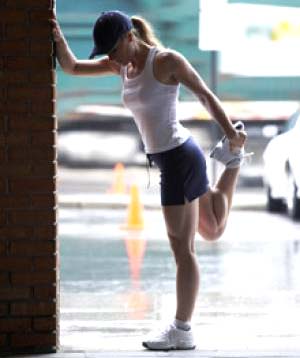Beneficial long legs like?
For years, scientists have known that the energy consumption of walking and jogging is highly related to the activities performed by muscles to lift and move limbs. But how much energy does it really take to travel? Does long legs really make a difference?
Dr. Herman Pontzer, associate professor of physical anthropology, developed a mathematical model for calculating energy consumption for bipedal and quadruped animals. His research is published in the recent edition of The Journal of Experimental Biology.
 (Photo: Washington University in St. Louis) 'When everything is balanced, the length of the leg is one of the main determinants of energy consumption,' said Dr. Pontzer. 'If two animals are the same except for the length of the leg, then the animal with longer legs will be more effective.'
(Photo: Washington University in St. Louis) 'When everything is balanced, the length of the leg is one of the main determinants of energy consumption,' said Dr. Pontzer. 'If two animals are the same except for the length of the leg, then the animal with longer legs will be more effective.'
Fossil records suggest that, two million years ago, there was a huge increase in the length of the legs in prehistoric people. Dr. Pontzer said that one reason for this increase may be energy savings because they have longer legs than other animals. 'If you increase the distance you travel every day, you can expect that evolution will impact your walking performance,' he said.
'That way, the energy you save when traveling can be spent on survival and reproduction.' Dr. Pontzer's model is an equation capable of predicting walking and jogging . The important thing is, this model predicts that the level of power generation - and hence the level of energy use - is related to the length of the leg. Long legs mean less force and less energy consumption.
To test his equation, Dr. Pontzer put people, goats and dogs on a treadmill in his laboratory and measured the amount of oxygen used during travel and running at different speeds. He discovered that this model is capable of explaining more than one variation in motor consumption compared to other predictors, including contact time and body weight, which is Show that this model is suitable for four-legged animals as well as two legs.
Thanh Van
According to Washington University in St. Louis, Dong Nai Department of Science and Technology
- Mysterious long legs
- Who said only men like long legs? Girls are crazy!
- How many legs does a rolling roller really have?
- Unexpected discovery of beverages and beneficial bacteria supplements
- Why do Neanderthals have short legs?
- Find out how to bring cancer medicine to people more effectively with beneficial bacteria
- Women with long legs are more prone to cancer?
- Curved legs turn into straight legs: It turns out people have suffered this much
- The horrifying truth behind the wall of the natural building grew feathers
- The shorter the legs, the faster
- Things may be unknown about legs
- Why do cats always landed with 4 legs?
 'Fine laughs' - Scary and painful torture in ancient times
'Fine laughs' - Scary and painful torture in ancient times The sequence of numbers 142857 of the Egyptian pyramids is known as the strangest number in the world - Why?
The sequence of numbers 142857 of the Egyptian pyramids is known as the strangest number in the world - Why? History of the iron
History of the iron What is alum?
What is alum?